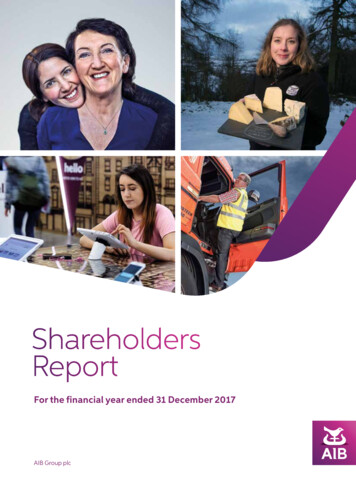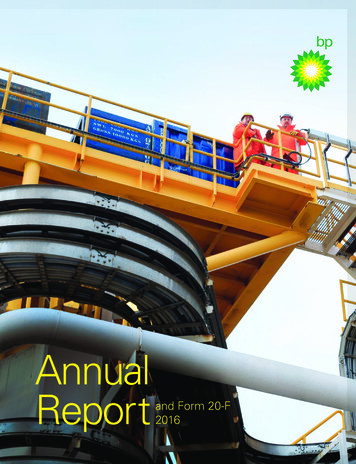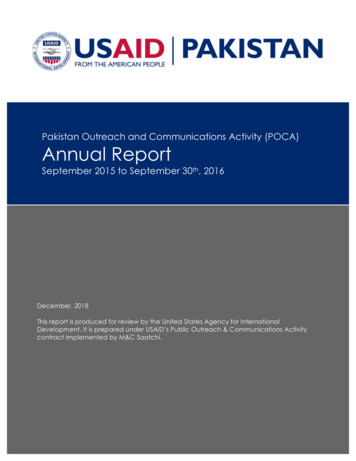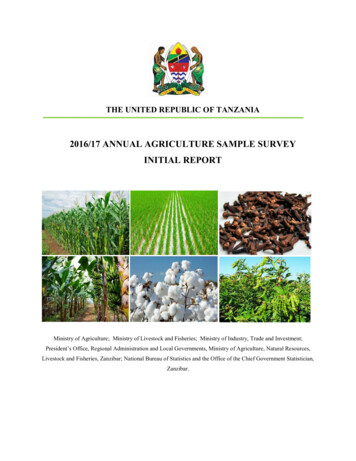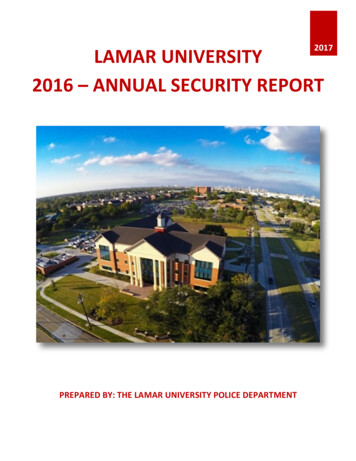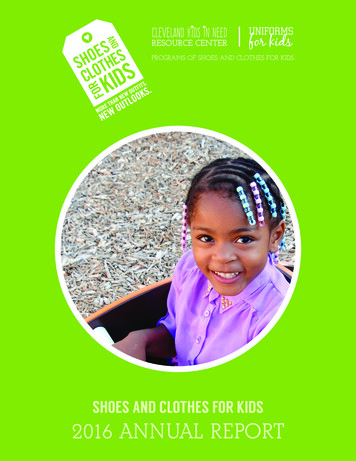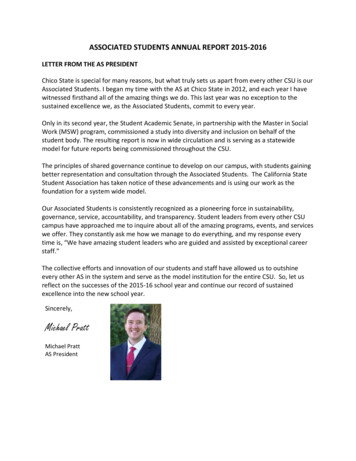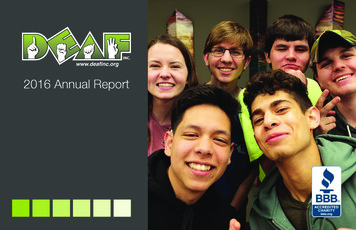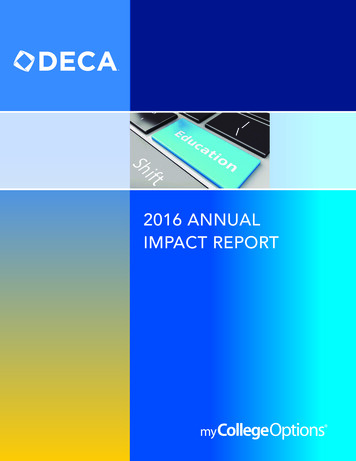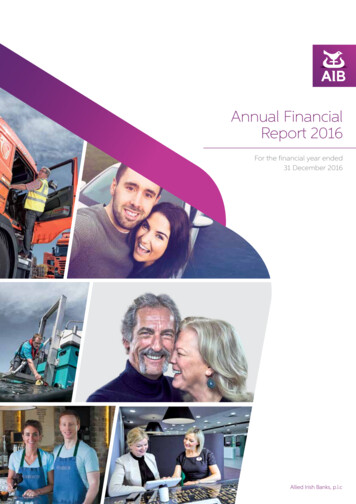
Transcription
Annual FinancialReport 2016For the financial year ended31 December 2016Allied Irish Banks, p.l.c
AIB DescriptionAIB is a financial services group operating mainly in the Republic of Ireland and the UK. We provide a broad rangeof services to personal, business and corporate customers in our target markets and have leading market shares inbanking products in the Republic of Ireland. Our business has been restructured in recent years and is now a customerfocused, profitable and lower risk institution. We are well positioned to continue to support the Irish economy whilegenerating sustainable shareholder returns.
Annual Financial Report 2016ContentsPage2016 Financial SummaryChairman’s statementChief Executive’s reviewGovernance at a glanceSustainable Banking3461416Business reviewOperating and financial reviewCapital management2443Risk managementPrincipal risks and uncertaintiesFrameworkIndividual risk types505962Governance and oversightThe BoardThe Leadership TeamGroup Directors’ ReportSchedule to Group Directors’ reportCorporate Governance reportReport of the Board Audit CommitteeReport of the Board Risk CommitteeReport of the Nomination and Corporate Governance CommitteeReport of the Remuneration CommitteeCorporate Governance Remuneration statementViability statementInternal ControlsOther governance informationSupervision and 11Financial statementsStatement of Directors’ responsibilitiesIndependent Auditors’ ReportConsolidated financial statementsNotes to the consolidated financial statementsParent company financial statementsNotes to the parent company financial statements213214221227355360General informationShareholder informationNew operating segmentsGlossary of termsPrincipal addressesIndex4154164334394401
Forward Looking StatementsThis document contains certain forward-looking statements with respect to the financial condition,results of operations and business of AIB Group and certain of the plans and objectives of the Group.These forward-looking statements can be identified by the fact that they do not relate only to historicalor current facts. Forward-looking statements sometimes use words such as ‘aim’, ‘anticipate’, ‘target’,‘expect’, ‘estimate’, ‘intend’, ‘plan’, ‘goal’, ‘believe’, ‘may’, ‘could’, ‘will’, ‘seek’, ‘continue’, ‘should’, ‘assume’,or other words of similar meaning. Examples of forward-looking statements include, among others,statements regarding the Group’s future financial position, capital structure, Government shareholdingin the Group, income growth, loan losses, business strategy, projected costs, capital ratios, estimatesof capital expenditures, and plans and objectives for future operations. Because such statements areinherently subject to risks and uncertainties, actual results may differ materially from those expressed orimplied by such forward-looking information. By their nature, forward-looking statements involve riskand uncertainty because they relate to events and depend on circumstances that will occur in the future.There are a number of factors that could cause actual results and developments to differ materially fromthose expressed or implied by these forward-looking statements. These are set out in the Principal risksand uncertainties on pages 50 to 58 in the 2016 Annual Financial Report. In addition to matters relatingto the Group’s business, future performance will be impacted by Irish, UK and wider European and globaleconomic and financial market considerations. Any forward-looking statements made by or on behalf ofthe Group speak only as of the date they are made. The Group cautions that the list of important factors onpages 50 to 58 of the 2016 Annual Financial Report is not exhaustive. Investors and others should carefullyconsider the foregoing factors and other uncertainties and events when making an investment decisionbased on any forward-looking statement.2
Annual Financial Report 20162016 Financial Highlights2015 Financial HighlightsNet interest margin(1)2.25%1.97%ProfitableandEfficientCost income ratio(2)52%49%Profit before tax 1,682m 1,914mReturn on equity(3)11.1%12.4%New lending(4) 8.7bnFranchiseGrowth 8.5bnMortgage market share36%34%Net promoter score (5)4536CET1transitionalfully g loans 56.1bn 57.0bnImpaired loans 9.1bn 13.1bnCustomer accounts 63.5bn 63.4bnContinued positive NIM expansion as the spreadwidens between yields on assets and liabilities,in particular redemption of legacy instruments.In line with the Group’s expectation to achievea cost income ratio of below 50% in the mediumterm.Sustainable underlying profit before tax inthe year enhanced by net credit provisionwritebacks of 294 million and exceptionalitems of 207 million.Reduction due to increase in ordinaryshareholders’ equity following the partialconversion of the 2009 preference shares inDecember 2015.Growth from strong momentum in all keysectors in Ireland and through syndicatedlending in Europe and the US. UK new lendingnegatively impacted by uncertainty around a UKexit from the EU.No 1 position in Mortgage Market Share for newlending in Ireland.Transactional NPS has increased reflectingthe continued enhancement of the customerexperience.Robust capital position, post proposed ordinarydividend of 250 million, with organic capitalaccretion through positive effect of profitsgenerated in the year and reduced riskweighted assets.Increase in earning loans 0.6 billion, excludingFX impact, with new lending and loansupgraded to earning higher than redemptionsand new to impaired over the year.Reduction in impaired loans reflects thecontinued implementation of sustainablerestructure solutions for customers andimproved economic conditions.Robust funding structure underpinned bylow cost deposit base. Further reduction interm deposits as current accounts continuedto increase in 2016.Net interest margin (“NIM”) excluding eligible liabilities guarantee (“ELG”) charge. NIM including ELG 2.23% in 2016 (2015: 1.94%).Before bank levies, regulatory fees and exceptional items. Cost income ratio including these items was 54% in 2016 (2015: 64%). Exceptional items aredetailed on page 30.(3)Return on average ordinary shareholders’ equity.(4)New lending for 2015 has been restated by 0.2 billion to exclude revolving credit.(5)The Net Promoter Score or NPS is a measurement program that tracks customers’ loyalty and advocacy and ranges from -100 to 100 (Q4 2016 v Q4 2015).(1)(2)3
Chairman’s statementIt is with great pleasure that the Boardcan now propose to declare a modestdividend. This is the clearest possibledemonstration of the financial recoveryof the bank. The dividend has beenset at a level which the Board feelsis sustainable and offers prospectsfor growth.Chairman’sStatementRichard PymChairmanChairing a banking institution is a challenging role,however, introducing an annual report which showsas much progress as this report does is one of thebetter moments. I don’t want to hide from whatwent before, but the recovery story is a good one.It is thus with great pleasure that the Board cannow propose to declare a modest dividend forthe financial year ending December 2016. Oncethe accounts are received at the AGM in April andsubject to shareholder approval, a dividend of 250 million will be paid on 9 May to shareholderson the register on the record date of 24 March.This is the clearest possible demonstration ofthe financial recovery of the bank. The dividendhas been set at a level which the Board feelsis sustainable and offers prospects for growth.However, the Board will be very prudent andrecognises the inherent financial risks in thebusiness, particularly the continued high levelof impaired loan balances.4These have fallen from 29 billion in 2013 to 9 billion today, but are still high compared toother major European banks. Addressing thisdisparity is an objective for the next few yearsand there are no easy solutions given the depthof the previous financial crisis and the challengesof navigating through the legal system when weneed to exercise security.The results for 2016 show a profit before tax of 1.7 billion, compared to 1.9 billion the previousyear reflecting strong business performance andreduced loan loss provision writebacks. Commonequity tier one capital on a ‘fully loaded’ basis is15.3%, up from 13.0% the previous year and it isthis improvement which provided the opportunityfor the Board to consider the dividend.The bank has undertaken a major remediationreview of tracker mortgage customers for whichprovision was made in the accounts in 2015. Theremediation process, which has made significantprogress, is putting customers back on trackers andcompensating them for the associated loss. We areadhering fully to the resolution framework put inplace by the Central Bank of Ireland, identifying andresolving all instances of incorrect charges. I wouldlike to apologise to those customers we have failed.We are putting it right, and if other failures come tolight we will put those right too.
Annual Financial Report 2016The principal risks which the bank considers areshown later in this report and I would encouragecurrent and prospective investors to consider thesecarefully. In this section I have already highlightedthe continued high level of impaired loan balances,the legal complexities of resolving them and alsothe complexities of historically sold products, butbanking is an inherently very risky business andthere are lots more risks to consider.In terms of economic risk, Ireland is exposed tothe United Kingdom, its major trading partner,leaving the European Union. This introduces shortterm economic risk but it also opens up longterm opportunities if firms currently located inthe UK wish to retain an operational base in theEU, particularly in an English speaking one withsimilarities in the legal system. There are indicationsof such firms wanting to move and we welcomethem joining us here. Ireland is a great place forinternational businesses to locate. However, onthe downside, they will inevitably look to the localfinancial firms in Ireland to hire staff from and thisincreases the risk of loss of key staff from acrossthe bank.We are delighted to have assembled a very highquality leadership and senior management teamand they have shown huge commitment andloyalty to the bank. I would like to thank colleaguesthroughout the bank who have worked so hardto make these results happen and cope with allthe projects and change we have thrown at them.Developing and nurturing the talent in the bank is akey board objective again for 2017.We were delighted to welcome Carolan Lennon andBrendan McDonagh who joined the Board team in2016. They bring additional skills and experience oftechnology and banking to the board table. I wouldlike to thank all the directors for their efforts onbehalf of the bank.There are two really tough postings on a bankboard, that is in chairing the audit and the riskcommittees, and I appreciate the very hard workthat Catherine Woods and Peter Hagan have putinto these roles. The remuneration committee ischaired very effectively by Jim O’Hara even thoughthe role of the committee is restricted in the thingsit can do.I would also like to thank our two executive directorsBernard Byrne, CEO, and Mark Bourke, CFO, for theirefforts and success during the year. They are hugelydedicated and professional, and excellent colleaguesto work with.Looking forward, we note that the Minister forFinance has appointed a syndicate of banks toprepare for the potential sale of some of the State’sshareholding in AIB which might occur in 2017.This will be dependent on the state of the financialmarkets and the Minister will want to ensure goodvalue for taxpayers. Following the proposedpayment of the ordinary share dividend of 250million, we will have returned 6.8 billion to thegovernment by way of dividend, capital, fees andcoupons. The Board has an objective to enabletaxpayers to recover in full their investment of 20.8billion over time and a share listing and sale wouldbe another step in that direction. The decision is inthe hands of the Minister, but the bank will be readywhen he decides and a successful conclusion wouldbe another important step in the full rehabilitationof AIB.Richard PymChairman1 March 2017Later this year we will be publishing for the first timea sustainability report, which is commonly called asocial impact report. It is not sufficient for a bank toproduce good financial results if it is not also makinga positive contribution to society as a whole and wehave started thinking about how we can report onthese issues in this new publication. I would like tothank our non-executive director Helen Normoylewho is supervising our work in this area in her roleof chairing our new sustainability committee.5
Chief Executive’s ReviewThe Group’s financial performance andcurrent market shares demonstrate thatAIB is the leading banking franchise in agrowing Irish economy.AIB is now in a position to pay an ordinarydividend and I am pleased that the bank isproposing a dividend payment for the fullyear 2016 of 250 million. Including thisdividend, AIB will have paid c. 6.8 billionin capital, fees, dividends, coupons andlevies to the State.Chief Executive’sReviewOur 2016 performance confirms that this hasoccurred. Our customers are more satisfied and chooseus more frequently to help them achieve theirfinancial ambitions; Our continued progress on digital enablementhas made the bank simpler and easier tooperate for customers and colleagues; Our strong profitability, with profit before taxat c. 1.7 billion in the year, has strengthenedour capital base and the reduction ofc. 4 billion in impaired loans has improvedour risk profile; and Our employees are more engaged and positiveabout the bank they work in as is clearlydemonstrated by the continuing improvementin our employee engagement scores.B
Annual Financial Report 2016 (1)Net interest margin (“NIM”) excluding eligible liabilities guarantee (“ELG”) charge. NIM including ELG 2.23% in 2016 (2015: 1.94%). (2)Before bank levies, regulatory fees and exceptional items. Cost income ratio including these items was 54% in 2016 (2015: 64%). Exceptional items are
